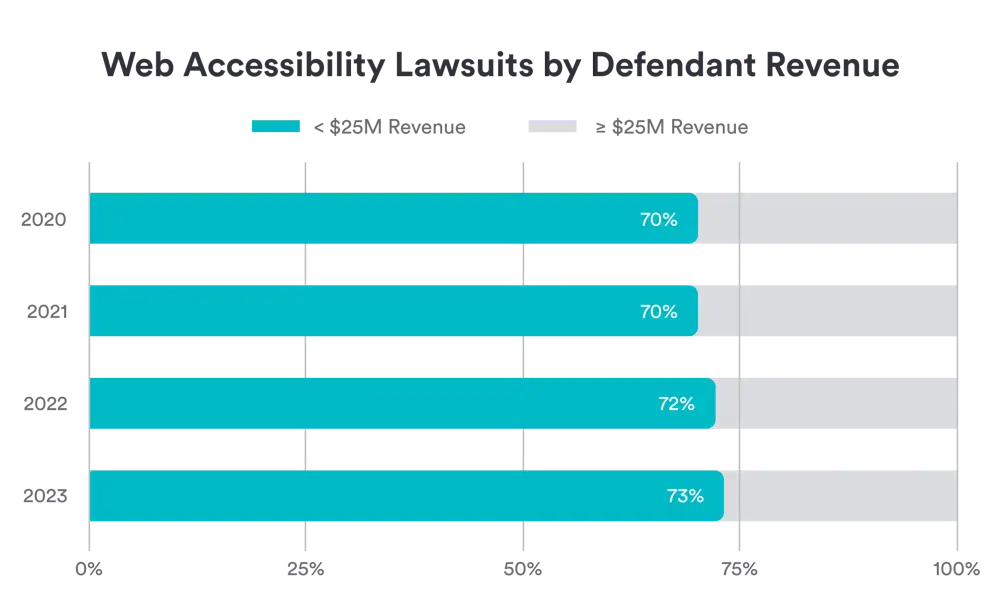Websites
Why Restaurant Website Accessibility Lawsuits Are On the Rise
Three possible reasons restaurant websites are being targeted for ADA violations.
Website accessibility lawsuits have been skyrocketing in the United States. Brought by a tiny number of law firms, these lawsuits have targeted businesses large and small for the better part of a decade. Dealing with a web accessibility lawsuit costs an estimated $25,000 for even a small business.
The substance of these cases is the allegation that the defendants’ websites are not accessible to users living with disabilities, and therefore fail to comply with the Americans with Disabilities Act (ADA).
Read more: BentoBox’s digital accessibility features
Digital accessibility is important. Everyone deserves the ability to use the internet and conduct business as freely as possible. Unfortunately, the ADA has not been updated to specify a set of standards that would make websites accessible to these users.
While this lack of clarity hurts users with disabilities, it also presents a challenge for businesses. Without a clear set of standards, business owners are never able to meet full compliance with the letter of the law — which leaves them vulnerable to web accessibility lawsuits.
Moreover, the opportunistic law firms sending out these lawsuits seem to be targeting restaurants in particular. While every type of business is vulnerable to website accessibility complaints, the last few years have seen a marked rise in restaurants being targeted by these lawsuits. This is a scary prospect for restaurant owners.
It is also a bit confusing. As of 2024, by far the most common business websites to be targeted by web accessibility lawsuits are those operating in the “Consumer Durables & Apparel” sector, according to a study by Accessibility.com. But the second-most targeted industry is “Food, Beverage & Tobacco.” Not only are website accessibility lawsuits against food businesses going up every year, every year restaurants make up a bigger and bigger share of all the lawsuits filed.
Given that more than 95% of websites fail to meet the specifications of the most recent web content guidelines, it’s not immediately clear why restaurant websites are the ones being targeted more and more.
In this article, we’ve formulated three theories as to why restaurants are being disproportionately threatened with website accessibility lawsuits. It’s a story that enters strange legal territory and wonders if the open legal questions around web accessibility are themselves making restaurants uniquely vulnerable targets.
What is clear, regardless of any theory, is this: restaurants need to take every step they can to make their websites accessible to users with disabilities. Not only does it ensure better experiences for customers, is it the best way to protect against lawsuits that seem to have hospitality businesses in their crosshairs.

RESOURCE
Restaurant Website Accessibility
Get a digitally accessible restaurant website that follows ADA guidelines and supports your business.
The rise of website accessibility lawsuits
It all began, like so many restaurant stories, with a dissatisfied customer.
One day in 2016, California resident Guillermo Robles sat down at his desktop computer, navigated to the website of Domino’s Pizza, and tried to place an order. It was the second time he’d attempted to do so. Like the first time, it didn’t work.
Robles, who was blind, accessed the internet using screen-reading software that would vocalize text and visual information aloud. Domino’s online ordering system wasn’t compatible with the software. The website, to Robles, was inaccessible.
Read more: What restaurants need to know about digital accessibility
Had Robles been unable to enter a physical Domino’s store due to his disability, it would have been clear that the company was in violation of the Americans with Disabilities Act, a federal law that required businesses to take steps to accommodate people living with disabilities. Passed in 1990, the ADA was written with physical spaces in mind.
But Robles’s story posed a question: shouldn’t the law’s guarantee of reasonable disability accommodation extend to digital experiences?
For years, the closest thing businesses have to clarity came from the 2019 ruling of Robles v. Domino’s, in which the Ninth Circuit held that the ADA applied to Domino’s digital technology because “the website and app connected customers to the goods and services of Domino’s physical restaurants.” Two years later, the Supreme Court declined to hear the case, leaving the ruling against Domino’s as the de facto legal precedent.

A refreshable braille display is one of the many tools available to vision-impaired computer users.
The Robles case made it (almost) official: businesses could be held liable for having inaccessible websites.
But it also posed a whole raft of other questions. If the thing that made Domino’s liable was that the website was an extension of the physical business (which was covered by ADA regulations) did that mean that only websites connected to physical businesses needed to be accessible?
Here was another question: Did the plaintiff have to be located physically near the restaurant? Robles, after all, claimed that he was harmed by the website because it prevented him from ordering a pizza. Now, presumably, he lived within the restaurant’s delivery radius. But what if Robles was located across the country and could never have received a pizza from that restaurant? Would he still have legal standing to sue?

President George H. W. Bush signed the Americans with Disabilities Act into law on July 26, 1990. Source: Encyclopedia Britannica
The most important question of all was, what were the actual rules of web accessibility?
The text of the ADA spells out hundreds of physical specifications very clearly. For example, it states that parking lots of up to 25 spaces must have at least one accessible parking space, parking lots between 26–50 spaces must have at least two, and so on. Rules like this allow builders to be certain they’ve satisfied the requirements of the law. How can businesses comply with the ADA’s digital standards if they don’t exist?
In March 2022, the Biden administration addressed some of these questions in a vague way. After years of courts following the Robles precedent, the Department of Justice announced that, yes, businesses needed to make their websites accessible to people with disabilities. But the announcement didn’t specify a set of standards that websites needed to comply with. Nor did it answer questions about who had standing to sue — which was why the Supreme Court intended to answer that question in 2023. Until the case was, anticlimactically, dropped by the plaintiff.
In 2023, more than 95% of websites failed to meet the specifications of WCAG 2 standards.
WebAIM
Meanwhile, in the wake of the Robles decision, a cottage industry sprung up to exploit the situation. Even though website accessibility was a legal gray area, that didn’t stop a small number of opportunistic law firms from hunting for business websites to target with lawsuits — or, more accurately, the threat of lawsuits. They sent out menacing letters by the thousands, pointing out everything wrong with a company’s website and demanding settlements.
To a greater extent than ever before, the businesses that received those threats were restaurants.
No one but the law firms filing these claims knows for sure why, but here are three possible reasons.
Theory 1: Proximity to the most active law firms
It’s important to highlight just how concentrated the ADA web accessibility game is. In 2023 — a year that saw an 82% increase in Food, Beverage & Tobacco businesses sued — more than 69% of all website accessibility lawsuits were filed by five law firms in the United States. Four of them, including the top three, were based in the state of New York. One was based in California.
The defendant businesses, interestingly, looked geographically similar. More than 72% of the cases filed in the U.S. targeted New York-based businesses. California was home to 18%. Third-place Florida hosted 5%. Combined, those states represented 96% of all web accessibility defendants in the country.
Another thing those states have in common is that they are home to many, many restaurants. In fact, those three states host 28% of all the restaurants in the U.S.

Source: Data Axle
Is it possible that restaurants are targeted disproportionately partly because they happen to be a type of business commonly found near the most aggressive law firms? There are reasons to believe so.
Aggressive law firms are active in states like New York and California because those states have human rights laws that guarantee accessibility. If a business is found liable for an ADA violation in those states, they have to not only pay compensatory damages for violating the federal law, but pay additionally for violating state law, too. In other words, the cases are more lucrative for the law firms. That’s why so many cases are brought against businesses in those states — and why the law firms are located there.
All four of those New York-based law firms are located in or near New York City. So are a huge percentage of the restaurants in New York State.
The point is this: Although other states have more restaurants, nowhere in the country is there more proximity between restaurants and aggressive ADA liability lawyers as in the area around New York City.
More than 69% of all website accessibility lawsuits in 2023 were filed by five law firms.
At this point, it’s important to reiterate the role played by one unanswered legal question: it is very possible that, to sue under the ADA, plaintiffs need to be physically close to the defendant business.
The issue is called the “tester” question. As in: could someone sue a business for an inaccessible website if they were just “testing” it for violations?
“A plaintiff bringing a lawsuit must have ‘standing,’ meaning they must allege some concrete injury that is traceable to the alleged wrongdoer’s actions,” wrote attorneys Sarahanne Vaughan and Anne Yuengert in The National Law Review. “Simply alleging that they could have been harmed is generally not enough. They must allege a specific harm they suffered.”
Emphasis on “generally.” In fact, the question has never been answered as to whether testers — who admit not even intending to buy anything from a business — are able to sue over web accessibility. This was the central issue the U.S. Supreme Court was going to decide in 2023, then failed to rule on when the plaintiff withdrew. But as Vaughan & Yuengert point out, all indications were that the court was going to rule that testers did not have standing.
All of which indicates that we live in a world in which, if you’re a law firm in the business of suing hundreds of businesses a year for ADA violations, it is safer to go after businesses located near you. That way, you don’t have to worry about the tester rule invalidating your case. (Should a court ruling ever answer that question.)
In summary, it’s very possible that restaurants — New York restaurants especially — are being hit with a growing number of web accessibility lawsuits because they happen to be a common type of business found within a short distance of these aggressive New York-based law firms.

BentoBox’s accessibility partner AudioEye reported their managed digital accessibility solution made businesses 67% less likely to receive a valid lawsuit claim compared to other industry solutions. Source: AudioEye
Theory 2: Restaurants make other standing requirements easier
Dovetailing with the above theory, it is also possible that restaurants make desirable targets for web accessibility lawsuits because they are physical businesses that are open to the public.
Recall that the Robles v. Domino’s ruling, which started the web accessibility legal movement, specified that it was the website’s connection to a physical store that invoked ADA protections. This implies that a lawsuit will be more likely to succeed if it targets a website that is, essentially, an extension of a physical business with whom the plaintiff could reasonably intend to transact.
The physical aspect of that equation is clear. Restaurant websites overwhelmingly represent physical storefront businesses.
The second part is about a business being open — not only to the public, but to anyone who walks in.
ADA law firms can (and do) sue many types of businesses for web accessibility issues. But given the questions around standing, it is potentially safer to accuse a restaurant of inaccessibility than, say, a dentist’s office. The dentist could challenge the idea that the tester was prevented from conducting business. The dentist could ask, “Were they a patient? Did they have a referral?”
The restaurant, meanwhile, is clearly a “business open to the public,” as the federal government’s 2022 rule states. It is plausible that any website tester located near a restaurant was prevented from placing an order with that restaurant or making a visit.
This theory is corroborated by the fact that the other most commonly-targeted type of business in 2023 were “Consumer Durables & Apparel” and “Retailing” — in other words, businesses with physical locations that anyone near them could claim to want to patronize, and thereby invoke ADA protections.
Theory 3: Restaurants tend to be small businesses
Not only does suing nearby restaurants preempt the question of standing that currently looms over web accessibility lawsuits, restaurants also make easy targets for the simple reason that, generally, restaurants tend to be small businesses.
Large businesses get hit with web accessibility suits often; 82% of the top 500 eCommerce retailers in the U.S. have received a lawsuit since 2018. But big businesses are harder to go after. Unlike many small businesses, they understand the need for web inaccessibility and take steps to provide it. (Hint, hint.) They mount more robust legal defenses, with bigger defense firms and more lawyers. Also, there are simply far fewer of them. For law firms sending out complaints on an industrial scale, it’s much easier to find violations among small businesses, which make up 99.9% of all U.S. businesses.
Not surprisingly, the proportion of small businesses being hit with web accessibility lawsuits is climbing.

Source: UsableNet’s 2023 Year-End Report
Restaurants, meanwhile, are overwhelmingly small businesses. Nine in ten have fewer than 50 employees; seven in ten are single-unit operations.
Given the aforementioned reasons why restaurants make for attractive targets for ADA law firms, their small size, it seems, makes them even easier to go after.
Restaurants need accessible websites
In 2022, after the Supreme Court declined to revise the ruling on Robles v. Domino’s, the pizza chain decided not to proceed to a court case in which they would have actually argued that their website was accessible. Like much of this legal gray area, important questions went unanswered. Instead, they settled with the plaintiff.
It’s fitting that the web accessibility lawsuit craze was kicked off by a suit brought against a restaurant, given the outsized role restaurants play in this ongoing story. Regardless of what is really on the minds of the lawyers who hunt businesses for having inaccessible websites, the upshot for restaurant operators is clear: it is essential to implement digital accessibility solutions to every website.
It is not a guarantee of compliance with the ADA; much of the problem is that there are not yet standards that would establish conformity with the law. But having digital accessibility solutions built into your site is a meaningful step towards security. In 2023, 80% of the businesses targeted with a lawsuit didn’t have any accessibility solution on their site at all.
The real solution, of course, is to build your websites with accessibility in mind from the start, and then to continually test the website for accessibility over time. This approach is best for avoiding liability, and also for ensuring a good experience for customers. Regardless of any legal threats, you don’t want to turn away anyone like Guillermo Robles, a would-be customer simply trying to order from your restaurant.
The ideal state of your restaurant website is that it functions like your restaurant front door: welcoming to all who want to enter for the right reasons, but with a lock on it to keep out unwanted intrusions.

RESOURCE
Restaurant Website Accessibility
Get a digitally accessible restaurant website that follows ADA guidelines and supports your business.
Recommended

Websites
No, Your Restaurant Doesn’t Need An App
July 10, 2024
Debunking a common myth about online ordering.

Design Inspiration
The Best Hotel Restaurant Websites of 2024
March 22, 2024
The most beautiful, revenue-driving websites for restaurants, bars, bakeries, and other hospitality businesses located within hotels.

Websites
How to Choose a Restaurant Website Design Company
May 20, 2021
What to look for when searching for a restaurant website design partner.




